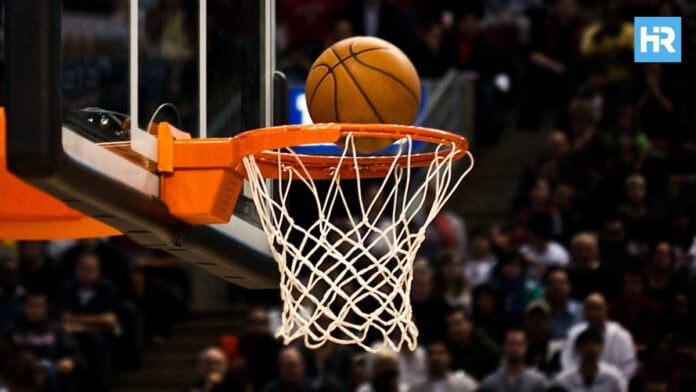The story of the 3-point shot began on November 13, 1967, when the American Basketball Association introduced the new rule. That night, the Indiana Pacers were down 118–116 against the Dallas Chaparrals with one second left. Jerry Harkness caught the inbound pass, 92 feet from the basket, and launched the ball toward the rim. It banked in, giving Indiana a 119–118 victory.
Many of the 2,500 fans in attendance thought the game was tied, unaware that the shot was worth three points. Harkness later recalled in Loose Balls, “We were running off the floor to huddle up for the overtime when the official, Joe Belmont, came up to me and said ‘Jerry, it’s over. That was a 3-pointer.’ I said, ‘I forgot all about that. A 3-pointer.’ Then we were celebrating again, because we found out that we won the game.”
- The first successful professional 3-pointer was Jerry Harkness’s 92-foot shot on November 13, 1967, in the ABA, giving the Indiana Pacers a 119–118 win.
- The NBA’s 3-point attempt rate has increased for ten straight seasons, from 22.2% in 2010–11 to 39.2% last season.
- Stephen Curry surpassed both Ray Allen and Reggie Miller in career 3-pointers after just 762 games and set the single-season record with 402 in 2015–16.
The ABA’s Influence and the NBA’s Adoption
It made sense that the 3-pointer immediately captured attention; ABA commissioner George Mikan, a former NBA legend, said in Loose Balls, “We called it the home run, because the 3-pointer was exactly that. It brought fans out of their seats.”
Effectively, the ABA’s goal was to make basketball more exciting. The league also introduced the red, white, and blue ball and the slam dunk contest. After the ABA–NBA merger in 1976, four teams joined the NBA: the Indiana Pacers, San Antonio Spurs, Denver Nuggets, and New Jersey Nets. However, the NBA did not adopt the 3-pointer until 1979, coinciding with the rookie season of Magic Johnson and Larry Bird.
By the early 1980s, some college conferences began experimenting with the rule, and the NCAA made it standard in 1986. High school basketball followed one year later.
How Coaches and Players Adjusted
When the 3-pointer arrived, coaches and players struggled to adapt. Former coach Hubie Brown explained in Loose Balls, “You have to tell your players to remember who the shooters are, and when those guys are 25 feet from the basket, get in their jocks and guard them. Don’t give them the 25-footer.”
Brown added that giving shooters permission to take long shots went against everything coaches had learned for decades. Former player Len Elmore, who competed in both the ABA and NBA, said, “It took a while for players to understand time and score situations, when to take it. You also recognize that players who hadn’t been accustomed to playing with a 3-point line really had to work to develop the range.”
Michael Jordan’s career demonstrates that adjustment. He played college basketball at North Carolina without a 3-point line and made only 9 of 52 attempts in his rookie NBA season. He did not shoot above 20 percent from three until his fifth year, but by the end of his career, he averaged more than 35 percent.
How 3-Point Shooting Took Over the League
The NBA’s reliance on the 3-pointer has grown continuously. The league-wide 3-point attempt rate rose from 22.2% in 2010–11 to 39.2% last season, ten straight years of increase. In 2015–16, only six teams took one-third or more of their shots from beyond the arc. By last season, 28 of 30 teams had done so. The Washington Wizards (31.9%) and San Antonio Spurs (31.4%) were the only teams below that threshold.
Miami Heat coach Erik Spoelstra reflected on how much the game had changed. He recalled a February 5, 2016, win in Charlotte, where the Heat went 0-for-9 from three but still won. Assistant coach Chris Quinn reminded him that it was a rare feat. Spoelstra laughed, saying, “There’s no way you can do that now.” That game remains the last time any NBA team won without making a 3-pointer.
Teams That Changed the Game’s Math
Several teams set new standards for 3-point usage.
- 1987–88 Boston Celtics under K.C. Jones became the first team to attempt 10% of their shots from three.
- 1988–89 New York Knicks under Rick Pitino were the first to reach 15%.
- 1994–95 Houston Rockets under Rudy Tomjanovich crossed 25%.
- 2002–03 Boston Celtics under Jim O’Brien reached 30%.
- 2009–10 Orlando Magic under Stan Van Gundy reached 35%.
- 2016–17 Houston Rockets under Mike D’Antoni hit both 40% and 45%.
- 2017–18 Houston Rockets, again under D’Antoni, reached 50%.
The NBA’s brief experiment with a shorter 3-point line from 1994–95 to 1996–97 caused a temporary spike in attempts.
One of the most defining transformations came in Orlando during the 2007–08 season. When Tony Battie suffered a season-ending shoulder injury, coach Stan Van Gundy moved Rashard Lewis from small forward to power forward, creating a lineup with four shooters around Dwight Howard. Orlando’s 3-point rate jumped from 15.8% to 32.2%. Van Gundy explained, “For most teams, it was a lineup they went to. I think we were one of the first that just started games that way.”
That season, the Magic rose from 19th to 4th in offensive efficiency and reached the NBA Finals a year later.
The Rise of 3-Point Icons
Reggie Miller entered the NBA in 1987 and ranked in the top 10 in made 3-pointers for 15 straight seasons, leading the league twice. He made 2,560 career 3-pointers in 1,389 games, averaging 1.8 per game.
Ray Allen, drafted in 1996, surpassed Miller’s total after 1,074 games.
Stephen Curry redefined what was possible. By his 762nd game, just 55% of Miller’s career total, he had already passed both legends. In 2005–06, Allen set the single-season record with 269 3-pointers. By 2021, that mark had been broken 16 times, with Curry responsible for six of them. His record of 402 3-pointers in the 2015–16 season came during his second MVP campaign, when the Golden State Warriors won 73 games.
Curry also popularized off-the-dribble shooting. Over eight seasons tracked by Second Spectrum, 54% of his attempts were pull-ups. Across the league, off-the-dribble 3s rose from 23% in 2013–14 to 30% in 2019–20, then slightly declined to 28% the following season.
Channing Frye and Brook Lopez Join the Revolution
Brook Lopez attempted 387 3-pointers in his ninth season, compared to just 31 total in his first eight. Channing Frye followed a similar path, as during his first four seasons with New York and Portland, Frye attempted only 70 3-pointers, 3% of his total shots. He took 61% of his attempts from mid-range.
When he joined the Phoenix Suns in 2009–10, the coaching staff encouraged him to stop taking mid-range shots and shoot from behind the arc. Frye recalled, “If you’re not the fastest or jump the highest or you’re not the most skilled, you have to have something that makes you difficult to guard.”
The staff challenged him to make 1,000 3-pointers during practice. “It took me four days,” he said. That season, Frye started 41 games and played 2,190 minutes, including 1,469 alongside Amar’e Stoudemire. In 1,325 minutes with Steve Nash, Stoudemire, and Frye together, the Suns averaged 118.0 points per 100 possessions, the highest among 449 three-man lineups that played at least 500 minutes.
Frye’s effective field goal percentage jumped from 44.4% to 57.3%, ranking ninth out of 253 players with at least 300 attempts that season.
The Decline of the Mid-Range Shot
As 3-pointers increased, mid-range shots nearly disappeared. Over the past decade, attempts in the paint have remained stable, but mid-range shots have dropped from 31% to 13%, while 3-pointers climbed from 22% to 39%.
In 2010–11, teams attempted 0.72 threes for every mid-range shot. Last season, the ratio was 3.05. The math is simple: mid-range shots yield about 0.8 points per attempt, while 3-pointers yield about 1.1.
Only two players—Chris Paul at 51.7% and Kevin Durant at 51.2%—have made at least half of their mid-range attempts on 300 or more tries in the past five seasons.
Offenses That Break the Mold
Despite the emphasis on spacing and shooting, not every elite team depends on the 3-pointer. The Miami Heat ranked seventh in 3-point attempt rate last season (43.2%) but finished just 18th in offensive efficiency. Kyle Lowry shot 39.6% from three and Duncan Robinson 40.8%, while Jimmy Butler shot 24% over two seasons and Bam Adebayo made seven career 3-pointers.
Spoelstra explained, “Offense usually is about getting guys to play together, bring out the best in each other and, ultimately, finding efficiency. That’s not necessarily or exclusively about shooting more 3s.”
The Los Angeles Lakers faced similar challenges. Five of their players made the league average or better from deep on at least 100 attempts, but not their star players, Anthony Davis, LeBron James, or Russell Westbrook.
In New Orleans, the Pelicans’ 3-point rate dropped from 40.3% to 34.2% under Stan Van Gundy, yet they remained top-10 offensively by ranking first in offensive rebounding and second in free-throw rate. Van Gundy said, “There’s certainly more than one way to play and be good.”
Defense in the Era of the 3
As offenses evolved, defenses faced new challenges. League-wide scoring efficiency rose to 111.7 points per 100 possessions, up from 110.1 the year before. The Lakers led the league defensively, allowing 106.8 points per 100 possessions, the same rate that ranked 19th in 2015–16.
Three-point accuracy has stayed consistent, rising only slightly from 35.8% to 36.7% over the past five years.
In 2019–20, the Milwaukee Bucks and Toronto Raptors led the league defensively despite allowing high 3-point volumes. Milwaukee allowed 14.0 made threes per game, then an NBA record, while Toronto’s opponents took 44% of their shots from beyond the arc. Both ranked top five in opponent field goal percentage at the rim.
When Van Gundy coached the Pelicans, he prioritized rim protection but initially used aggressive screen coverages. Opponents averaged 16.3 made threes per game through 29 games, and New Orleans ranked 29th defensively. After switching to drop coverage, the team improved. “It’s getting harder and harder to defend,” Van Gundy said.
The Raptors’ opponent 3-point percentage rose from 33.7% to 37.9%, the largest increase in eight years. The Miami Heat, once elite at limiting threes, allowed opponents to take 46% of their shots from long range last season—the highest rate in NBA history. Spoelstra said, “It’s like plugging holes in a dam.”
Toronto coach Nick Nurse remained confident, saying, “That has to be what your goal is if you believe in it. We wouldn’t be trying to concoct these systems and do all this work if we just thought it was all down to luck.”
The Future of the NBA 3 Point Line
Teams that shot at or above the league-average 3-point percentage won 67.4% of their games last season, up from 62.3% in 2015–16. Although the growth in attempts slowed slightly (+0.8%), the long-term trend continues upward.
Spoelstra reflected, “Like any trend, there becomes a tipping point at some point. When that’ll be, I have no idea. When everybody starts doing something, that’s when a tipping point happens.”
Nick Nurse added, “I would be open-minded enough to believe it could switch back the other way.”






